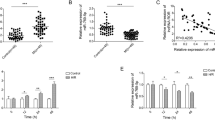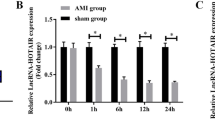Abstract
Background
Myocardial ischemia and reperfusion injury (MI/RI) is a complex pathophysiological process, which can lead to severe myocardial injury. The long noncoding RNA alpha-2-macroglobulin antisense RNA 1 (A2M-AS1) has been revealed to be abnormally expressed in MI, However, its function in MI and the potential mechanism are still unclear.
Objective
To evaluate the functional role of A2M-AS1 in hypoxia/reoxygenation (H/R)-induced neonatal cardiomyocytes and its potential molecular mechanism.
Methods
Dataset GSE66360 was obtained from GEO database for analyzing the RNA expression of A2M-AS1 and interleukin 1 receptor type 2 (IL1R2). KEGG pathway enrichment analysis of the genes that co-expressed with A2M-AS1 was performed. Human neonatal cardiomyocytes were subjected to H/R to construct in vitro models. QRT-PCR and Western blot were adopted to test the levels of mRNA and protein. The viability and apoptosis of cardiomyocytes were tested by CCK-8 and flow cytometry assays, respectively.
Results
The expression of A2M-AS1 was notably downregulated in H/R-treated cardiomyocytes. Overexpression of A2M-AS1 can notably enhance the cell viability of H/R-damaged cardiomyocytes, whereas knockdown of A2M-AS1 showed the opposite outcomes. Besides, a negative correlation was showed between A2M-AS1 and IL1R2 expression. In H/R-treated cardiomyocytes, overexpression of IL1R2 weakened the promoting proliferation and anti-apoptosis effects caused by overexpressing A2M-AS1, however, IL1R2-knockdown abolished the anti-proliferation and pro-apoptosis effects caused by silencing A2M-AS1.
Conclusion
This study demonstrates the potential regulatory role of A2M-AS1/ IL1R2 axis in cardiomyocytes suffered from H/R, and provides insight into the protection of MI/RI.





Similar content being viewed by others
Data availability
The data in this study is available from the corresponding author on reasonable request.
References
Anderson JL, Morrow DA (2017) Acute myocardial infarction. N Engl J Med 376:2053–2064
Annapoorani P, Dhandapany PS, Sadayappan S, Ramasamy S, Rathinavel A, Selvam GS (2006) Cardiac isoform of alpha-2 macroglobulin—a new biomarker for myocardial infarcted diabetic patients. Atherosclerosis 186:173–176
Bajaj A, Sethi A, Rathor P, Suppogu N, Sethi A (2015) Acute complications of myocardial infarction in the current era: diagnosis and management. J Investig Med 63:844–855
Betgem RP, de Waard GA, Nijveldt R, Beek AM, Escaned J, van Royen N (2015) Intramyocardial haemorrhage after acute myocardial infarction. Nat Rev Cardiol 12:156–167
Cao X, Wang X, Ling Y, Song X, Yang P, Liu Y, Liu L, Wang L, Guo J, Chen A (2014) Comparison of the degree of autophagy in neonatal rat cardiomyocytes and H9c2 cells exposed to hypoxia/reoxygenation. Clin Lab 60:809–814
Chen H, Li X (2019) LncRNA ROR is involved in cerebral hypoxia/reoxygenation-induced injury in PC12 cells via regulating miR-135a-5p/ROCK1/2. Am J Transl Res 11:6145–6158
Chen J, Hu Q, Zhang BF, Liu XP, Yang S, Jiang H (2019) Long noncoding RNA UCA1 inhibits ischaemia/reperfusion injury induced cardiomyocytes apoptosis via suppression of endoplasmic reticulum stress. Genes Genomics 41:803–810
Chi Y, Wang D, Wang J, Yu W, Yang J (2019) Long non-coding RNA in the pathogenesis of cancers. Cells 8:1015
Coulter KR, Wewers MD, Lowe MP, Knoell DL (1999) Extracellular regulation of interleukin (IL)-1beta through lung epithelial cells and defective IL-1 type II receptor expression. Am J Respir Cell Mol Biol 20:964–975
Ding J, Berryman DE, Kopchick JJ (2011) Plasma proteomic profiles of bovine growth hormone transgenic mice as they age. Transgenic Res 20:1305–1320
Dubois CM, Ruscetti FW, Palaszynski EW, Falk LA, Oppenheim JJ, Keller JR (1990) Transforming growth factor beta is a potent inhibitor of interleukin 1 (IL-1) receptor expression: proposed mechanism of inhibition of IL-1 action. J Exp Med 172:737–744
Ferrè F, Colantoni A, Helmer-Citterich M (2016) Revealing protein-lncRNA interaction. Brief Bioinform 17:106–116
Frantz S, Tillmanns J, Kuhlencordt PJ, Schmidt I, Adamek A, Dienesch C, Thum T, Gerondakis S, Ertl G, Bauersachs J (2007) Tissue-specific effects of the nuclear factor kappaB subunit p50 on myocardial ischemia–reperfusion injury. Am J Pathol 171:507–512
Giulietti M, Righetti A, Principato G, Piva F (2018) LncRNA co-expression network analysis reveals novel biomarkers for pancreatic cancer. Carcinogenesis 39:1016–1025
Gutschner T (2015) Silencing long noncoding RNAs with genome-editing tools. Methods Mol Biol 1239:241–250
Hartman MHT, Groot HE, Leach IM, Karper JC, van der Harst P (2018) Translational overview of cytokine inhibition in acute myocardial infarction and chronic heart failure. Trends Cardiovasc Med 28:369–379
Hausenloy DJ, Yellon DM (2013) Myocardial ischemia–reperfusion injury: a neglected therapeutic target. J Clin Investig 123:92–100
Hu C, Tkebuchava T, Hu D (2019) Managing acute myocardial infarction in China. Eur Heart J 40:1179–1181
Ishiguro T, Takeda J, Fang X, Bronson H, Olson DM (2016) Interleukin (IL)-1 in rat parturition: IL-1 receptors 1 and 2 and accessory proteins abundance in pregnant rat uterus at term—regulation by progesterone. Physiol Rep 4:e12866
Jin H, Yu J (2019) Lidocaine protects H9c2 cells from hypoxia-induced injury through regulation of the MAPK/ERK/NF-kappaB signaling pathway. Exp Ther Med 18:4125–4131
Kalogeris T, Bao Y, Korthuis RJ (2014) Mitochondrial reactive oxygen species: a double edged sword in ischemia/reperfusion vs preconditioning. Redox Biol 2:702–714
Krijnen PA, Nijmeijer R, Meijer CJ, Visser CA, Hack CE, Niessen HW (2002) Apoptosis in myocardial ischaemia and infarction. J Clin Pathol 55:801–811
Li X, Dai Y, Yan S, Shi Y, Han B, Li J, Cha L, Mu J (2017a) Down-regulation of lncRNA KCNQ1OT1 protects against myocardial ischemia/reperfusion injury following acute myocardial infarction. Biochem Biophys Res Commun 491:1026–1033
Li Z, Dou P, Liu T, He S (2017b) Application of long noncoding RNAs in osteosarcoma: biomarkers and therapeutic targets. Cell Physiol Biochem 42:1407–1419
Li X, Luo S, Zhang J, Yuan Y, Jiang W, Zhu H, Ding X, Zhan L, Wu H, Xie Y et al (2019a) lncRNA H19 alleviated myocardial I/RI via suppressing miR-877-3p/Bcl-2-mediated mitochondrial apoptosis. Mol Ther Nucleic Acids 17:297–309
Li Z, Han K, Zhang D, Chen J, Xu Z, Hou L (2019b) The role of long noncoding RNA in traumatic brain injury. Neuropsychiatr Dis Treat 15:1671–1677
Luo M, Sun Q, Zhao H, Tao J, Yan D (2019) Long noncoding RNA NEAT1 sponges miR5 to enhance myocardial ischemia–reperfusion injury via MAPK6 activation. J Cell Physiol 235:105–113
Ma L, Liu H, Xie Z, Yang S, Xu W, Hou J, Yu B (2014) Ginsenoside Rb3 protects cardiomyocytes against ischemia–reperfusion injury via the inhibition of JNK-mediated NF-kappaB pathway: a mouse cardiomyocyte model. PLoS ONE 9:e103628
Matsushima S, Tsutsui H, Sadoshima J (2014) Physiological and pathological functions of NADPH oxidases during myocardial ischemia–reperfusion. Trends Cardiovasc Med 24:202–205
Orlando S, Sironi M, Bianchi G, Drummond AH, Boraschi D, Yabes D, Mantovani A (1997) Role of metalloproteases in the release of the IL-1 type II decoy receptor. J Biol Chem 272:31764–31769
Orrem HL, Shetelig C, Ueland T, Limalanathan S, Nilsson PH, Husebye T, Aukrust P, Seljeflot I, Hoffmann P, Eritsland J et al (2018) Soluble IL-1 receptor 2 is associated with left ventricular remodelling in patients with ST-elevation myocardial infarction. Int J Cardiol 268:187–192
Qian Y, Mao ZD, Shi YJ, Liu ZG, Cao Q, Zhang Q (2018) Comprehensive analysis of miRNA-mRNA-lncRNA networks in non-smoking and smoking patients with chronic obstructive pulmonary disease. Cell Physiol Biochem 50:1140–1153
Qiu L, Liu X (2019) Identification of key genes involved in myocardial infarction. Eur J Med Res 24:22
Ransohoff JD, Wei Y, Khavari PA (2018) The functions and unique features of long intergenic non-coding RNA. Nat Rev Mol Cell Biol 19:143–157
Ravindran S, Kurian GA (2017) The role of secretory phospholipases as therapeutic targets for the treatment of myocardial ischemia reperfusion injury. Biomed Pharmacother 92:7–16
Ritchie ME, Phipson B, Wu D, Hu Y, Law CW, Shi W, Smyth GK (2015) limma powers differential expression analyses for RNA-sequencing and microarray studies. Nucleic Acids Res 43:e47
Roberts OL, Holmes K, Muller J, Cross DA, Cross MJ (2009) ERK5 and the regulation of endothelial cell function. Biochem Soc Trans 37:1254–1259
Sebastiao MJ, Gomes-Alves P, Reis I, Sanchez B, Palacios I, Serra M, Alves PM (2019) Bioreactor-based 3D human myocardial ischemia/reperfusion in vitro model: a novel tool to unveil key paracrine factors upon AMI. Transl Res 215:57–74
Sims JE, Dower SK (1994) Interleukin-1 receptors. Eur Cytokine Netw 5:539–546
Sun G, Lu Y, Li Y, Mao J, Zhang J, Jin Y, Li Y, Sun Y, Liu L, Li L (2017) miR-19a protects cardiomyocytes from hypoxia/reoxygenation-induced apoptosis via PTEN/PI3K/p-Akt pathway. Biosci Rep. https://doi.org/10.1042/BSR20170899
Thind GS, Agrawal PR, Hirsh B, Saravolatz L, Chen-Scarabelli C, Narula J, Scarabelli TM (2015) Mechanisms of myocardial ischemia–reperfusion injury and the cytoprotective role of minocycline: scope and limitations. Future Cardiol 11:61–76
Toldo S, Schatz AM, Mezzaroma E, Chawla R, Stallard TW, Stallard WC, Jahangiri A, Van Tassell BW, Abbate A (2012) Recombinant human interleukin-1 receptor antagonist provides cardioprotection during myocardial ischemia reperfusion in the mouse. Cardiovasc Drugs Ther 26:273–276
Tong G, Wang Y, Xu C, Xu Y, Ye X, Zhou L, Zhu G, Zhou Z, Huang J (2019) Long non-coding RNA FOXD3-AS1 aggravates ischemia/reperfusion injury of cardiomyocytes through promoting autophagy. Am J Transl Res 11:5634–5644
Wang K, Liu F, Liu CY, An T, Zhang J, Zhou LY, Wang M, Dong YH, Li N, Gao JN et al (2016) The long noncoding RNA NRF regulates programmed necrosis and myocardial injury during ischemia and reperfusion by targeting miR-873. Cell Death Differ 23:1394–1405
Xi J, Li QQ, Li BQ, Li N (2020) miR-155 inhibition represents a potential valuable regulator in mitigating myocardial hypoxia/reoxygenation injury through targeting BAG5 and MAPK/JNK signaling. Mol Med Rep 21:1011–1020
Zhang Y, Hu S, Chen Y (2015) Hepatocyte growth factor suppresses hypoxia/reoxygenation-induced XO activation in cardiac microvascular endothelial cells. Heart Vessels 30:534–544
Zhang W, Li Y, Wang P (2018) Long non-coding RNA-ROR aggravates myocardial ischemia/reperfusion injury. Braz J Med Biol Res 51:e6555
Zhang X, Hong R, Chen W, Xu M, Wang L (2019) The role of long noncoding RNA in major human disease. Bioorg Chem 92:103214
Zhou W, Liu T, Saren G, Liao L, Fang W, Zhao H (2019) Comprehensive analysis of differentially expressed long non-coding RNAs in non-small cell lung cancer. Oncol Lett 18:1145–1156
Author information
Authors and Affiliations
Contributions
XYQ conceived and instructed the work. XNL and YD collected the public data and performed the bioinformatics analysis. XLS,FFZ,WJW and MJS carried out a series of tests. YXL and QY analyzed the experimental data. XLS wrote the manuscript. All authors read and approved the final manuscript.
Corresponding author
Ethics declarations
Conflict of interest
Xue-Lian Song, Fei-Fei Zhang, Wen-Jing Wang, Xin-Ning Li, Yi Dang, Ying-Xiao Li, Qian Yang, Mei-Jing Shi, and Xiao-Yong Qi declare that they have no conflict of interest.
Additional information
Publisher's Note
Springer Nature remains neutral with regard to jurisdictional claims in published maps and institutional affiliations.
Electronic supplementary material
Below is the link to the electronic supplementary material.
Rights and permissions
About this article
Cite this article
Song, XL., Zhang, FF., Wang, WJ. et al. LncRNA A2M-AS1 lessens the injury of cardiomyocytes caused by hypoxia and reoxygenation via regulating IL1R2. Genes Genom 42, 1431–1441 (2020). https://doi.org/10.1007/s13258-020-01007-6
Received:
Accepted:
Published:
Issue Date:
DOI: https://doi.org/10.1007/s13258-020-01007-6




